Nikon D5000
-
-
Written by Gordon Laing
Nikon D5000 Movie Mode
The D5000 becomes Nikon’s second DSLR to feature video recording, and at the time of writing, one of only four models to do so from any manufacturer; the others are Nikon’s own D90 and Canon’s EOS 5D Mark II and EOS 500D / Rebel T1i, although others are on their way.
Other than having an articulated screen, the implementation is identical to that on the earlier D90, and as such can record video at 320×216, 640×424 or 1280×720 pixels, all at 24fps and with optional mono sound recorded using a built-in microphone; as before, there’s no external microphone input.
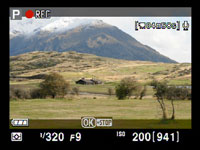 |
Video is compressed using the Motion JPEG system and stored in an AVI wrapper. The maximum file size is 2GB, although additional restrictions limit the HD mode to five minutes and the lower resolution modes to 20 minutes. The D5000 will stop recording at whichever comes first: the time limit or file size. You’re looking at about 2.5MB per second for the HD mode with audio, using the D5000’s relatively high bit-rate of just under 40Mbit/s.
The D5000’s movie mode is an extension of Live View: with Live View running, you simply press the OK button to start filming and again to stop. If you’re using the lower resolution modes, the image will fill the same screen area as normal Live View, but if you’re shooting in 720p, there’ll be thin grey bars at the top and bottom of the image to indicate the wider 16:9 frame.
On the left is a sample movie shot in the D5000’s HD movie mode using the default settings; registered members of Vimeo can download the original clip here. We filmed the same sequence using the Canon EOS 500D / T1i moments apart, so for comparison you can also download its clip in either its 720p / 30fps mode or the 1080p / 20fps mode.
Like other DSLR movie modes (prior to the 5D Mark II’s latest firmware update), the exposure is mostly automatic with the shutter and sensitivity adjusted automatically while filming, although you can lock them or apply compensation before starting. Nikon gives you a little extra aperture control over Canon’s fully automatic system though: you can manually set the f-number in Aperture Priority mode (before entering Live View) and values from the maximum down to f8 are used. Apertures smaller than f8, such as f11 to f22, are ignored, so for the maximum depth-of-field, you’ll need to use f8 with wider focal lengths.
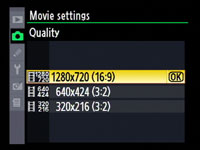 | 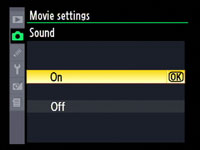 |
VR is supported while filming to reduce camera-shake, but at the cost of higher power consumption, and you may also hear the system working in the background. It’s also possible to take a still photo while filming by simply pressing the shutter release button, although it will stop the video and won’t automatically restart afterwards.
Probably the biggest limitation though regards focusing: you can autofocus before you start filming, but once the D5000 starts ‘rolling’, it becomes manual focus only. This is why having a lens with a smooth focusing ring and distance markings is very useful, and why the basic DX 18-55mm VR kit lens is therefore far from ideal. The manual also warns of banding under artificial light and ‘distortion’ if the camera is panned horizontally or an object moves at high speed through the frame.
Like the D90 and other video-equipped DSLRs, the results are a mixed bag: embrace the unique qualities a DSLR brings to video recording and you can enjoy spectacular results which would otherwise be difficult or impossible to achieve with a conventional camcorder. Fail to work within its limitations though, or simply become unlucky, and you can end up with very disappointing output.
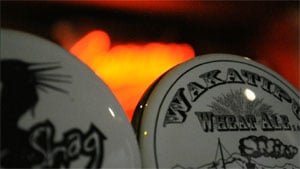
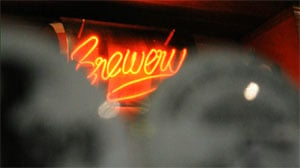 |
Let’s start with the good news. DSLRs have large sensors compared to traditional camcorders, which allows them to perform better in low light, and also achieve a smaller depth of field. In practice this bears-out with the D5000. The D5000’s video really is much cleaner in low light than a typical consumer camcorder (see lens caveats below), and the potential depth of field much smaller.
You can easily throw the background out of focus, or switch focus from one subject to another – a technique we’re all familiar with from professional filming, but something that’s almost impossible to achieve on a consumer camcorder; see right for two grabs from the same D5000 movie sequence demonstrating the effect.
DSLRs also have the flexibility of interchangeable lenses, allowing you to film with exotic models including fisheyes and long telephotos, or those with macro or perspective control. Try doing that with your camcorder. The audio is also not bad considering it’s coming from a small built-in microphone, but beware as both focusing and zoom adjustments can be heard as faint scraping in the background. The D5000’s articulated screen also gives it greater compositional flexibility than the D90, although most camcorders also feature flexible monitors.
Now for the bad news. Hollywood and the pro movie industry may be used to manually focusing their lenses while filming, but most consumers aren’t. It takes some practice to get it right, and ideally requires a lens with a very smooth focusing ring and distance markings. It’s best-suited to rehearsed sequences with marked focus distances than spontaneous situations.
You’ll also notice zoom lenses for still cameras weren’t designed with video in mind: adjusting the focal length just isn’t as smooth, proportional or even quiet as a camcorder. It’s almost impossible to manually zoom the lens without twisting and shaking the camera, and DSLRs are simply the wrong shape to be held comfortably in front of your face while filming video for any length of time.
|
Speaking of lenses, it’s also important to compare like with like. If you buy the D5000 kit, you may be surprised to find its video footage actually suffering from greater noise than your camcorder under low light. This is because the kit lens’s f3.5-5.6 aperture is typically four to eight times slower than an average camcorder lens. So under the same light, a camcorder could be operating at a low sensitivity, while the D5000 could be pushed to a considerably higher one. If both cameras were operating at the same sensitivity, then the D5000 would deliver cleaner results, but with the kit lens, the Nikon will almost certainly be working at a much higher sensitivity and effectively lose much of its advantage.
Like the D90 before it, the D5000’s movie mode also suffers from motion artefacts often referred to as wobble, skew or jello. This is a well-known issue with CMOS sensors with rolling shutters which record each frame from top to bottom before returning to the top again for the next one. Should the camera or subject move during this process, the image can appear to tear, skew or wobble. Now many video cameras, both amateur and professional, employ CMOS sensors, but some suffer more from this effect than others. Sadly the D5000 suffers more than most. Panning or zooming, fast-moving subjects or simply handheld work can often result in very undesirable artefacts. So like the D90, making the most of the movie mode involves learning what kind of motions best avoid the skewing effect and working around them.
Finally, the D5000’s video eats through both your card and battery at a rate of knots, so always carry spares or you will get caught short.
Ultimately like the D90 and other video-equipped DSLRs, the D5000 will not replace your camcorder and if you try and use it in the same way for ‘normal’ shooting it will invariably disappoint or frustrate. Whether it’s the discomfort of holding the body, jerky zoom operation, necessity of manual focus, risk of skewing artefacts or the basic mono sound, it’s just not a viable video camera for all situations.
But the D5000 can be a great complement to a camcorder, grabbing sequences with which would otherwise be compromised or even impossible. It has the potential to excel in low light and deliver an unusually small depth of field, and can also exploit unusual optics. In each of these respects it can thrash a conventional camcorder and approaches the capability of pro models costing a small fortune, but for the best effect you’ll need to learn its foibles and ditch the kit lens for something brighter with superior manual focus. Just understand its limitations, work around them and realise it will never replace a normal video camera or the way you’d use it.
You can see more example footage filmed with the D5000’s movie mode in our Nikon D5000 video tour.




